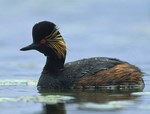Abstract
Aim Despite the complexity of population dynamics, most studies concerning current changes in bird populations reduce the trajectory of population change to a linear trend. This may hide more complex patterns reflecting responses of bird populations to changing anthropogenic pressures. Here, we address this complexity by means of multivariate analysis and attribute different components of bird population dynamics to different potential drivers.
Location Czech Republic.
Methods We used data on population trajectories (1982–2019) of 111 common breeding bird species, decomposed them into independent components by means of the principal component analysis (PCA), and related these components to multiple potential drivers comprising climate, land use change and species’ life histories.
Results The first two ordination axes explained substantial proportion of variability of population dynamics (42.0 and 12.5% of variation in PC1 and PC2 respectively). The first axis captured linear population trend. Species with increasing populations were characterized mostly by long lifespan and warmer climatic niches. The effect of habitat was less pronounced but still significant, with negative trends being typical for farmland birds, while positive trends characterized birds of deciduous forests. The second axis captured the contrast between hump-shaped and U-shaped population trajectories and was even more strongly associated with species traits. Species migrating longer distances and species with narrower temperature niches revealed hump-shaped population trends, so that their populations mostly increased before 2000 and then declined. These patterns are supported by the trends of total abundances of respective ecological groups.
Main Conclusion Although habitat transformation apparently drives population trajectories in some species groups, climate change and associated species traits represent crucial drivers of complex population dynamics of central European birds. Decomposing population dynamics into separate components brings unique insights into non-trivial patterns of population change and their drivers, and may potentially indicate changes in the regime of anthropogenic effects on biodiversity.
